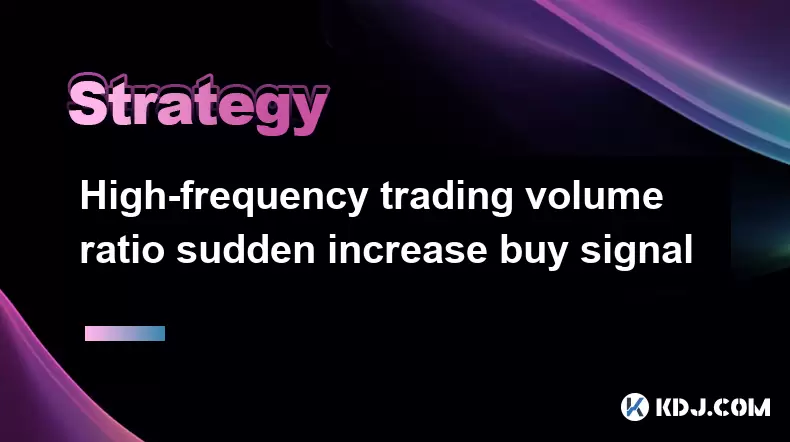-
 bitcoin
bitcoin $122090.672462 USD
1.59% -
 ethereum
ethereum $4493.758974 USD
0.56% -
 xrp
xrp $3.033145 USD
0.65% -
 tether
tether $1.000629 USD
0.00% -
 bnb
bnb $1169.854250 USD
7.07% -
 solana
solana $230.954786 USD
-0.19% -
 usd-coin
usd-coin $0.999785 USD
0.00% -
 dogecoin
dogecoin $0.256108 USD
-1.12% -
 tron
tron $0.342333 USD
-0.12% -
 cardano
cardano $0.859632 USD
-0.10% -
 hyperliquid
hyperliquid $48.932146 USD
-2.25% -
 chainlink
chainlink $22.345466 USD
-1.29% -
 ethena-usde
ethena-usde $1.000217 USD
-0.03% -
 avalanche
avalanche $31.203456 USD
1.93% -
 sui
sui $3.579145 USD
1.05%
High-frequency trading volume ratio sudden increase buy signal
A sudden increase in the volume ratio can signal a buy opportunity in crypto, but traders must consider context and use additional indicators to confirm.
Jun 04, 2025 at 12:43 pm

High-frequency trading (HFT) has become a significant part of the cryptocurrency market, with its ability to execute a large number of orders at lightning speed. The volume ratio in high-frequency trading is a key metric that traders often monitor to gain insights into market dynamics. A sudden increase in the volume ratio can be interpreted as a potential buy signal, but understanding the context and mechanics behind this phenomenon is crucial for making informed trading decisions.
Understanding High-Frequency Trading Volume Ratio
The volume ratio in the context of high-frequency trading refers to the ratio of the current trading volume to the average trading volume over a specified period. This metric helps traders assess the intensity of trading activity relative to historical norms. A sudden increase in the volume ratio indicates that the current trading volume has spiked significantly compared to the average, suggesting heightened market interest or potential shifts in market sentiment.
In the cryptocurrency market, high-frequency trading algorithms often react to these spikes by executing trades at a rapid pace. When the volume ratio suddenly increases, it can signal that a large number of traders are entering the market, possibly in response to new information or market events. This influx of trading activity can be a precursor to price movements, making it a critical indicator for traders looking for buy signals.
Identifying a Sudden Increase in Volume Ratio
To identify a sudden increase in the volume ratio, traders need to monitor real-time data and compare it against historical averages. Here are the steps to do so:
- Select a time frame: Decide on the period over which you want to calculate the average volume. Common time frames include 5-day, 10-day, or 30-day averages.
- Calculate the average volume: Use historical data to compute the average trading volume for the selected time frame.
- Monitor current volume: Keep an eye on the current trading volume in real-time.
- Compute the volume ratio: Divide the current trading volume by the average trading volume to get the volume ratio.
- Set a threshold: Determine a threshold for what constitutes a 'sudden increase.' This could be a specific percentage or a multiple of the average volume.
- Analyze the ratio: If the current volume ratio exceeds the set threshold, it may indicate a sudden increase.
For example, if the average trading volume over the past 10 days is 1 million units and the current trading volume spikes to 3 million units, the volume ratio would be 3. If your threshold for a sudden increase is a ratio of 2.5 or higher, this would qualify as a sudden increase and potentially a buy signal.
Interpreting a Sudden Increase in Volume Ratio as a Buy Signal
A sudden increase in the volume ratio can be interpreted as a buy signal for several reasons. Firstly, a high volume ratio suggests that there is significant interest in the asset, which can lead to price appreciation. Secondly, large volumes often accompany market movements, and a sudden increase can indicate the beginning of a bullish trend.
However, interpreting this as a buy signal requires careful consideration of other market factors. For instance, the context of the volume increase is crucial. If the increase is due to a positive news event or a favorable market development, it is more likely to be a genuine buy signal. Conversely, if the increase is driven by speculative trading or market manipulation, it might not be a reliable indicator.
Confirming the Buy Signal with Additional Indicators
While a sudden increase in the volume ratio can be a strong buy signal, it is essential to confirm this signal with other technical indicators to increase the probability of a successful trade. Some commonly used indicators include:
- Moving Averages: Compare the current price to moving averages to determine if the asset is trending upwards.
- Relative Strength Index (RSI): Use the RSI to assess whether the asset is overbought or oversold. A reading below 70 can indicate that the asset is not yet overbought and may have room for further appreciation.
- MACD (Moving Average Convergence Divergence): Look for bullish crossovers in the MACD to confirm upward momentum.
- Candlestick Patterns: Identify bullish candlestick patterns such as the hammer or engulfing patterns to support the buy signal.
By combining the volume ratio with these additional indicators, traders can make more informed decisions and reduce the risk of false signals.
Implementing a Trading Strategy Based on Volume Ratio
To implement a trading strategy based on a sudden increase in the volume ratio, follow these steps:
- Set up real-time data feeds: Ensure you have access to real-time trading volume data for the cryptocurrency you are interested in.
- Configure alerts: Set up alerts to notify you when the volume ratio exceeds your predetermined threshold.
- Analyze additional indicators: Once an alert is triggered, analyze other technical indicators to confirm the buy signal.
- Execute the trade: If the additional indicators support the buy signal, execute the trade at the current market price or set a limit order at a favorable entry point.
- Set stop-loss and take-profit levels: To manage risk, set stop-loss orders to limit potential losses and take-profit orders to secure gains.
For example, if you receive an alert that the volume ratio for Bitcoin has suddenly increased to 3, you would then check the RSI and MACD. If the RSI is below 70 and the MACD shows a bullish crossover, you might decide to buy Bitcoin. You could set a stop-loss at 5% below your entry price and a take-profit at 10% above your entry price to manage the trade effectively.
Risks and Considerations
While a sudden increase in the volume ratio can be a powerful buy signal, it is not without risks. Market volatility is a significant factor in the cryptocurrency market, and high-frequency trading can exacerbate price fluctuations. Additionally, false signals can occur if the volume increase is driven by temporary or manipulated market conditions.
It is also important to consider transaction costs associated with high-frequency trading. The rapid execution of trades can lead to higher fees, which can eat into potential profits. Furthermore, liquidity can be a concern, as sudden increases in volume may not always be sustainable and could lead to liquidity traps.
FAQs
Q: Can a sudden increase in volume ratio be a sell signal as well?A: Yes, a sudden increase in the volume ratio can also be a sell signal, particularly if it occurs in the context of a bearish market or negative news. Traders should analyze the overall market sentiment and other technical indicators to determine whether the volume increase signals a sell opportunity.
Q: How can I differentiate between a genuine volume increase and one caused by market manipulation?A: Differentiating between genuine and manipulated volume increases can be challenging. Look for corroborating evidence such as news events, social media sentiment, and other market indicators. Additionally, monitor the sustainability of the volume increase over time; manipulated volumes may not be sustained.
Q: Are there specific cryptocurrencies where volume ratio signals are more reliable?A: The reliability of volume ratio signals can vary across different cryptocurrencies. Generally, more established cryptocurrencies like Bitcoin and Ethereum tend to have more reliable signals due to higher liquidity and trading volumes. However, it's essential to analyze each cryptocurrency individually and consider its unique market dynamics.
Q: How often should I check the volume ratio to identify sudden increases?A: The frequency of checking the volume ratio depends on your trading strategy and time frame. For high-frequency trading, real-time monitoring is necessary. For longer-term trading, checking the volume ratio daily or weekly may be sufficient. Set up alerts to notify you of sudden increases to ensure you do not miss potential buy signals.
Disclaimer:info@kdj.com
The information provided is not trading advice. kdj.com does not assume any responsibility for any investments made based on the information provided in this article. Cryptocurrencies are highly volatile and it is highly recommended that you invest with caution after thorough research!
If you believe that the content used on this website infringes your copyright, please contact us immediately (info@kdj.com) and we will delete it promptly.
- BlockDAG, DOGE, HYPE Sponsorship: Crypto Trends Shaping 2025
- 2025-10-01 00:25:13
- Deutsche Börse and Circle: A StableCoin Adoption Powerhouse in Europe
- 2025-10-01 00:25:13
- BlockDAG's Presale Buzz: Is It the Crypto to Watch in October 2025?
- 2025-10-01 00:30:13
- Bitcoin, Crypto, and IQ: When Genius Meets Digital Gold?
- 2025-10-01 00:30:13
- Stablecoins, American Innovation, and Wallet Tokens: The Next Frontier
- 2025-10-01 00:35:12
- NBU, Coins, and Crypto in Ukraine: A New Yorker's Take
- 2025-10-01 00:45:14
Related knowledge

Practical parameter settings for a Bitcoin multi-timeframe moving average system
Sep 18,2025 at 10:54pm
Optimizing Timeframe Combinations for Bitcoin Trading1. Selecting appropriate timeframes is crucial when building a multi-timeframe moving average sys...

How can I filter out false breakouts in Dogecoin high-frequency trading?
Sep 22,2025 at 01:00am
Understanding False Breakouts in Dogecoin Trading1. A false breakout occurs when Dogecoin's price appears to move beyond a defined support or resistan...

Techniques for identifying tops and bottoms in the Bitcoin on-chain NVT model
Sep 20,2025 at 07:54pm
Understanding the NVT Model in Bitcoin Analysis1. The Network Value to Transactions (NVT) ratio is often described as the 'P/E ratio' of the cryptocur...

What does the surge in open interest in Bitcoincoin futures mean?
Sep 20,2025 at 11:18pm
Understanding the Surge in Dogecoin Futures Open Interest1. A surge in open interest within Dogecoin futures indicates a growing number of active cont...

How can I use the Ethereum USDT premium to gauge market sentiment?
Sep 18,2025 at 11:55pm
Understanding the Ethereum USDT Premium1. The Ethereum USDT premium refers to the price difference between USDT (Tether) traded on Ethereum-based plat...

What should I do if Ethereum staking yields decline?
Sep 20,2025 at 06:18am
Understanding the Causes Behind Declining Ethereum Staking Yields1. The Ethereum network transitioned to a proof-of-stake consensus mechanism with the...

Practical parameter settings for a Bitcoin multi-timeframe moving average system
Sep 18,2025 at 10:54pm
Optimizing Timeframe Combinations for Bitcoin Trading1. Selecting appropriate timeframes is crucial when building a multi-timeframe moving average sys...

How can I filter out false breakouts in Dogecoin high-frequency trading?
Sep 22,2025 at 01:00am
Understanding False Breakouts in Dogecoin Trading1. A false breakout occurs when Dogecoin's price appears to move beyond a defined support or resistan...

Techniques for identifying tops and bottoms in the Bitcoin on-chain NVT model
Sep 20,2025 at 07:54pm
Understanding the NVT Model in Bitcoin Analysis1. The Network Value to Transactions (NVT) ratio is often described as the 'P/E ratio' of the cryptocur...

What does the surge in open interest in Bitcoincoin futures mean?
Sep 20,2025 at 11:18pm
Understanding the Surge in Dogecoin Futures Open Interest1. A surge in open interest within Dogecoin futures indicates a growing number of active cont...

How can I use the Ethereum USDT premium to gauge market sentiment?
Sep 18,2025 at 11:55pm
Understanding the Ethereum USDT Premium1. The Ethereum USDT premium refers to the price difference between USDT (Tether) traded on Ethereum-based plat...

What should I do if Ethereum staking yields decline?
Sep 20,2025 at 06:18am
Understanding the Causes Behind Declining Ethereum Staking Yields1. The Ethereum network transitioned to a proof-of-stake consensus mechanism with the...
See all articles










































































